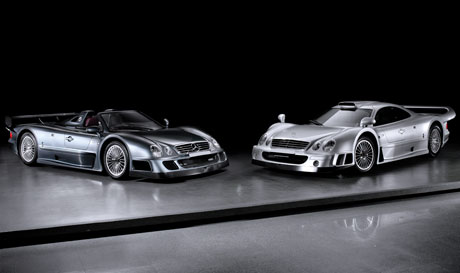SCM Analysis
Detailing
| Vehicle: | 2005 Mercedes-Benz CLK GTR |
| Number Produced: | 25 (possibly 26) |
| Original List Price: | $1,547,620 |
| Tune Up Cost: | $2,500 |
| Distributor Caps: | n/a (solid state ignition) |
| Chassis Number Location: | VIN tag at windshield, plaque on console |
| Engine Number Location: | Stamped atop back of block |
| Club Info: | Mercedes-Benz Club of America, 1907 Lelaray St. Colorado Springs, CO 80909 |
| Website: | http://www.mbca.org |
These cars sold at RM’s Automobiles of London Auction in England on October 28, 2009-the coupe for $865,208, and the roadster for $1,020,034.
One of the enduring fantasies in the automobile hobby is that of a pure racing car to fling about on public roads. The image of blazing across the Futa Pass in your 250 GTO or TR, the exhaust howling behind you as (to use P.J. O’Rourke’s wonderful phrase) “the oncoming curves uncoil at you like a crazed Mamba snake,” is one of those sweaty-palms dreams that has driven car collectors since the beginning.
It’s why racing cars, particularly those of the 1950s and ’60s, sell for huge premiums over their road equivalents. And it is what has kept mechanics, restorers, and replica builders busy for decades. It is one of the core myths of our business.
Nobody in his right mind would use one
The problem with myths, dreams, and fantasies is that they are exactly that, and the cold reality is that pure racing cars have not been acceptable road cars since the late 1950s. As race tracks evolved from rough public roads to carefully designed venues with sculpted turns and baby’s bottom-smooth asphalt, race cars became both perfectly suited to perfect tracks and completely unsuited to public roads.
Newer racers are too low, too stiff, too demanding, too noisy, and generally devoid of the comforts that make road cars work well. I’m not suggesting the road-legal variants of racing cars aren’t fabulous things to lust after, only that nobody in his right mind would actually use one much. This limits the market to wealthy dreamers and collectors.
These two Mercedes-Benz CLK GTRs are perfect examples of my point. If there was a more breathtakingly beautiful or more car-lust inducing road-legal automobile available at the turn of this century, I can’t recall it. Even though frighteningly expensive, if they were truly great cars you would expect them to have sold quickly, which does not appear to have been the case. According to my research, the 25 cars required to meet FIA rules were constructed between winter of 1998 and summer of 1999. The cars featured here were completed in 2005 and 2006; that’s between six and seven years later. What happened?
A broker friend recalls being offered one in 1999 (he had no idea what to do with it), and the only other car I can find public record of was delivered in 2004. Did some or most of the 25 cars sit unsold in AMG’s warehouse for all that time? Why? I’ve been unable to find anyone who can tell me.
It’s generally my job at SCM to write about racing cars, but these clearly aren’t racing cars; they have never and will never participate in a serious race (though their siblings certainly did). Neither are they road cars in the common usage of the term. You could drive them on the road, but nobody has and most likely nobody will.
These cars are uncompromised mechanical art
These cars fit a third category of collectible automobiles-uncompromised mechanical art. The motivations for and rewards from owning them are more like those for watches or firearms: You revel in the complexity, the workmanship, the precision, and the artistry of the package; you marvel at how wonderfully it does what it’s supposed to do; you take great pleasure in simply being able to own such a beautiful and rare example. After that, worrying about whether it’s really any fun to use on a regular basis would sully the experience. That’s not why you collect things like this.
The market for “ultra-supercars” is thin but real, and it is being chased by a bewildering assortment of small manufacturers who may not ever actually deliver a car. Suggested prices seem to be in the $750k-$1.3m range for new cars in this category, such as the Noble M15, Koenigsegg CCXR, and Bugatti Veyron. The CLK GTRs are effectively brand new, but they’re ten-year-old designs with potential garage-rot issues and were not known for being user friendly.
On the other hand, they are Mercedes AMG, not some obscure off-brand, and they are iconic in appearance and reputation. These factors seem to balance out because both cars sold for substantially less than they cost their original owners, but for about what a comparable new ultra-supercar would sell for today. I’d say that both the CLK GTR Coupe and CLK GTR Roadster were rationally bought and will serve their respective new owners as glittering bookends to substantial collections.
